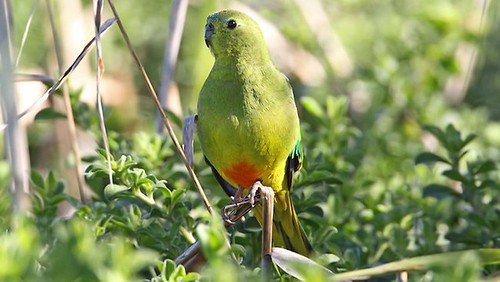 A rare juvenile male orange-bellied parrot photographed during the national count at Werribee. Picture: Chris Tzaros/Birds Australia
A rare juvenile male orange-bellied parrot photographed during the national count at Werribee. Picture: Chris Tzaros/Birds Australia
This winter they have found eight of the critically endangered orange-bellied parrots on the mainland, including two in South Australia.
SA survey co-ordinator Bob Green says this is an incredible strike rate.
"There are less than 50 in the wild, so to find eight in a survey is an extraordinary effort," he said.
"It's like looking for a needle in a haystack."
In 2006, concerns for the rare orange-bellied parrot blocked development of the Bald Hills Wind Farm project in Gippsland but the project was eventually given the go-ahead by then federal environment minister Ian Campbell.
The winter counts are held each year in coastal areas of South Australia, Victoria and King Island.
In SA, 25 volunteers searched sites ranging from Piccaninnie Ponds Conservation Park near the SA/Victorian border to Port Noarlunga. They contributed more than 150 hours of survey time to this "extremely important" count of the migratory parrot in its wintering habitat.
The two parrots in SA were on private land on the northern shore of Lake Alexandrina, mixed in with flocks of the closely related elegant parrot.
"These are the first orange-bellied parrots sighted in SA since April, when two birds were found at Piccaninnie Ponds Conservation Park," Mr Green said.
During the surveys volunteers also record other closely related parrots which use similar habitats.
The final figures for SA included 154 blue-winged parrots, 85 elegant parrots and two rock parrots.
"All four species occur in similar habitats and look quite similar which makes ... finding the extremely rare orange-bellied parrot even more challenging" Mr Green said.
"Dedicated training sessions held early each winter help to arm the volunteers with the necessary skills to correctly identify these parrots."